| Clash of Cultures Reading with Questions |
|---|
| www.studenthandouts.com ↣ American History ↣ American History Readings with Questions |
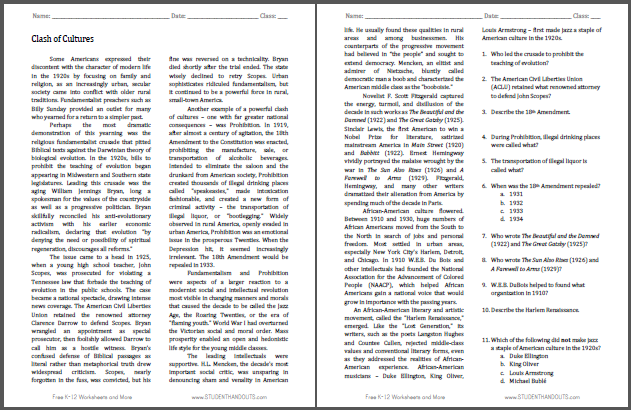 Some Americans expressed their discontent with the character of modern life in the 1920s by focusing on family and religion, as an increasingly urban, secular society came into conflict with older rural traditions. Fundamentalist preachers such as Billy Sunday provided an outlet for many who yearned for a return to a simpler past.
Some Americans expressed their discontent with the character of modern life in the 1920s by focusing on family and religion, as an increasingly urban, secular society came into conflict with older rural traditions. Fundamentalist preachers such as Billy Sunday provided an outlet for many who yearned for a return to a simpler past.Perhaps the most dramatic demonstration of this yearning was the religious fundamentalist crusade that pitted Biblical texts against the Darwinian theory of biological evolution. In the 1920s, bills to prohibit the teaching of evolution began appearing in Midwestern and Southern state legislatures. Leading this crusade was the aging William Jennings Bryan, long a spokesman for the values of the countryside as well as a progressive politician. Bryan skillfully reconciled his anti-evolutionary activism with his earlier economic radicalism, declaring that evolution "by denying the need or possibility of spiritual regeneration, discourages all reforms." The issue came to a head in 1925, when a young high school teacher, John Scopes, was prosecuted for violating a Tennessee law that forbade the teaching of evolution in the public schools. The case became a national spectacle, drawing intense news coverage. The American Civil Liberties Union retained the renowned attorney Clarence Darrow to defend Scopes. Bryan wrangled an appointment as special prosecutor, then foolishly allowed Darrow to call him as a hostile witness. Bryan's confused defense of Biblical passages as literal rather than metaphorical truth drew widespread criticism. Scopes, nearly forgotten in the fuss, was convicted, but his fine was reversed on a technicality. Bryan died shortly after the trial ended. The state wisely declined to retry Scopes. Urban sophisticates ridiculed fundamentalism, but it continued to be a powerful force in rural, small-town America. Another example of a powerful clash of cultures—one with far greater national consequences—was Prohibition. In 1919, after almost a century of agitation, the 18th Amendment to the Constitution was enacted, prohibiting the manufacture, sale, or transportation of alcoholic beverages. Intended to eliminate the saloon and the drunkard from American society, Prohibition created thousands of illegal drinking places called "speakeasies," made intoxication fashionable, and created a new form of criminal activity—the transportation of illegal liquor, or "bootlegging." Widely observed in rural America, openly evaded in urban America, Prohibition was an emotional issue in the prosperous Twenties. When the Depression hit, it seemed increasingly irrelevant. The 18th Amendment would be repealed in 1933. Fundamentalism and Prohibition were aspects of a larger reaction to a modernist social and intellectual revolution most visible in changing manners and morals that caused the decade to be called the Jazz Age, the Roaring Twenties, or the era of "flaming youth." World War I had overturned the Victorian social and moral order. Mass prosperity enabled an open and hedonistic life style for the young middle classes. The leading intellectuals were supportive. H.L. Mencken, the decade's most important social critic, was unsparing in denouncing sham and venality in American life. He usually found these qualities in rural areas and among businessmen. His counterparts of the progressive movement had believed in "the people" and sought to extend democracy. Mencken, an elitist and admirer of Nietzsche, bluntly called democratic man a boob and characterized the American middle class as the "booboisie." Novelist F. Scott Fitzgerald captured the energy, turmoil, and disillusion of the decade in such works as The Beautiful and the Damned (1922) and The Great Gatsby (1925). Sinclair Lewis, the first American to win a Nobel Prize for literature, satirized mainstream America in Main Street (1920) and Babbitt (1922). Ernest Hemingway vividly portrayed the malaise wrought by the war in The Sun Also Rises (1926) and A Farewell to Arms (1929). Fitzgerald, Hemingway, and many other writers dramatized their alienation from America by spending much of the decade in Paris. African-American culture flowered. Between 1910 and 1930, huge numbers of African Americans moved from the South to the North in search of jobs and personal freedom. Most settled in urban areas, especially New York City's Harlem, Detroit, and Chicago. In 1910 W.E.B. Du Bois and other intellectuals had founded the National Association for the Advancement of Colored People (NAACP), which helped African Americans gain a national voice that would grow in importance with the passing years. An African-American literary and artistic movement, called the "Harlem Renaissance," emerged. Like the "Lost Generation," its writers, such as the poets Langston Hughes and Countee Cullen, rejected middle-class values and conventional literary forms, even as they addressed the realities of African-American experience. African-American musicians—Duke Ellington, King Oliver, Louis Armstrong—first made jazz a staple of American culture in the 1920s. Questions with answers in bold: 1. Who led the crusade to prohibit the teaching of evolution? William Jennings Bryan 2. The American Civil Liberties Union (ACLU) retained what renowned attorney to defend John Scopes? Clarence Darrow 3. Describe the 18th Amendment. It prohibited the manufacture, sale, or transportation of alcoholic beverages. 4. During Prohibition, illegal drinking places were called what? speakeasies 5. The transportation of illegal liquor is called what? bootlegging 6. When was the 18th Amendment repealed? a. 1931 b. 1932 c. 1933 d. 1934 7. Who wrote The Beautiful and the Damned (1922) and The Great Gatsby (1925)? F. Scott Fitzgerald 8. Who wrote The Sun Also Rises (1926) and A Farewell to Arms (1929)? Ernest Hemingway 9. W.E.B. DuBois helped to found what organization in 1910? National Association for the Advancement of Colored People (NAACP) 10. Describe the Harlem Renaissance. It was an African-American literary and artistic movement of the 1920s. 11. Which of the following did not make jazz a staple of American culture in the 1920s? a. Duke Ellington b. King Oliver c. Louis Armstrong d. Michael Bublé Click here to print. |
 | 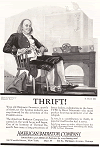 |
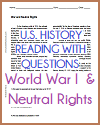 | 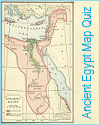 | 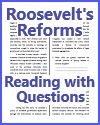 | 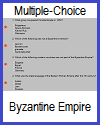 |
| www.studenthandouts.com ↣ American History ↣ American History Readings with Questions |








